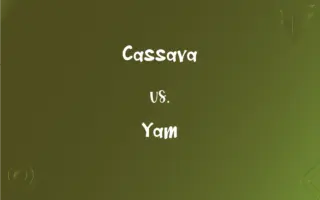Pierogi vs. Pedaheh: What's the Difference?
Edited by Aimie Carlson || By Harlon Moss || Published on February 10, 2024
Pierogi are Eastern European dumplings filled with various ingredients, while pedaheh refers to a similar Ukrainian dumpling, often with a specific filling like potatoes or cheese.

Key Differences
Pierogi are a traditional Eastern European dish, particularly popular in Poland, consisting of dough dumplings filled with a variety of ingredients, including cheese, potatoes, meat, and vegetables. They can be served boiled, fried, or baked. On the other hand, pedaheh (often spelled "pyrohy" or "perohê") are Ukrainian dumplings that closely resemble pierogi, typically filled with similar ingredients but are particularly known for potato and cheese fillings.
The filling in pierogi often varies widely, reflecting a diversity of culinary traditions across Eastern Europe. From sweet to savory, pierogi fillings can include a mix of cultural influences. Whereas pedaheh tend to have a more consistent filling, usually sticking to traditional Ukrainian recipes and ingredients, often emphasizing local flavors and simpler, homestyle cooking.
In terms of preparation, pierogi can be versatile, with the method of cooking ranging from boiling to frying, which can influence their texture and flavor. Pedaheh, while also versatile, are traditionally boiled and sometimes served with a dollop of sour cream or a side of sautéed onions, reflecting the Ukrainian preference for certain serving styles.
The dough of pierogi is typically simple, made from flour, water, and eggs, creating a tender and versatile casing for the fillings. Pedaheh also use a similar dough, but the technique and thickness can vary slightly, possibly reflecting regional variations in Ukrainian cuisine and often resulting in a slightly different texture from pierogi.
In terms of cultural significance, pierogi have become a symbol of Eastern European cuisine, popular in various countries and adopted into different culinary traditions. Pedaheh, while also enjoyed outside Ukraine, are more specifically associated with Ukrainian culture and traditions, often featured in Ukrainian festivals and family gatherings.
ADVERTISEMENT
Comparison Chart
Origin
Eastern Europe, especially Poland
Ukraine
Filling Variety
Wide range (meat, cheese, vegetables, fruits)
Typically potatoes, cheese, or traditional fillings
Cooking Methods
Boiled, fried, or baked
Usually boiled
Dough Composition
Flour, water, eggs
Similar, but regional variations affect texture
Cultural Significance
Symbol of Eastern European cuisine
Strongly associated with Ukrainian culture
ADVERTISEMENT
Pierogi and Pedaheh Definitions
Pierogi
Eastern European dumplings with various fillings.
We enjoyed delicious meat and cheese pierogi at the Polish festival.
Pedaheh
Traditional Ukrainian boiled dumplings.
We had pedaheh topped with caramelized onions at the Ukrainian fair.
Pierogi
Traditional dumplings reflecting a mix of cultural influences.
The restaurant's menu featured pierogi with unique, modern fillings.
Pedaheh
A staple in Ukrainian cuisine, often homemade.
Every Sunday, our family gathers to make pedaheh together.
Pierogi
Dumplings made of dough, often filled with cheese or potatoes.
My grandmother makes the best potato and onion pierogi.
Pedaheh
Dumplings reflecting Ukrainian culinary traditions.
At the cultural festival, the pedaheh stand was always crowded.
Pierogi
A versatile dish, served boiled, fried, or baked.
For dinner, we had fried pierogi with sour cream.
Pedaheh
Simple, comforting food central to Ukrainian family meals.
For our holiday dinner, we prepared pedaheh as the main dish.
Pierogi
A popular Eastern European comfort food.
At the Christmas market, pierogi were the most sought-after dish.
Pedaheh
Ukrainian dumplings, commonly filled with potatoes and cheese.
My favorite Ukrainian dish is pedaheh with potato filling.
Pierogi
A semicircular dumpling with any of various fillings, such as finely chopped meat or vegetables, that is often sautéed after being boiled.
Pedaheh
(North America) A type of Ukrainian dumpling, similar to Polish pierogi. Traditionally called pyrohy or varenyky.
Pierogi
(North America) A square- or crescent-shaped dumpling of unleavened dough, stuffed with sauerkraut, cheese, mashed potatoes, cabbage, onion, meat, or any combination of these, or with a fruit filling.
FAQs
How are pedaheh traditionally served?
Pedaheh are usually boiled and served with sour cream or onions.
What are pierogi?
Pierogi are Eastern European dumplings with various fillings, popular in Poland.
Can pierogi be sweet?
Yes, pierogi can have sweet fillings like fruits or sweet cheese.
Do pedaheh have a cultural significance in Ukraine?
Yes, they are a significant part of Ukrainian cuisine and cultural traditions.
Are pierogi and pedaheh the same?
They are similar, but pedaheh are specifically Ukrainian and may have slight variations.
What is the typical filling for pedaheh?
Pedaheh are often filled with potatoes and cheese.
Is it common to fry pedaheh?
Boiling is more traditional for pedaheh, but they can be fried for a different texture.
Can pedaheh be filled with meat?
Yes, though potato and cheese are more traditional.
Are pierogi considered fast food?
Not traditionally, but they can be found in fast-food formats in some regions.
Can you freeze pierogi?
Yes, pierogi can be frozen either before or after cooking.
Are pedaheh suitable for vegetarians?
Yes, especially the potato and cheese varieties.
How long have pierogi been part of Eastern European cuisine?
Pierogi have been a staple for centuries, with origins tracing back to medieval times.
What are some common pierogi fillings?
Fillings include cheese, potatoes, meat, sauerkraut, mushrooms, and fruit.
Is pedaheh making a social activity in Ukraine?
Yes, making pedaheh is often a communal and family activity.
What is the best way to cook pierogi?
It depends on preference; they can be boiled, fried, or baked.
Are pierogi popular outside of Eastern Europe?
Yes, they have gained popularity in many countries worldwide.
Is pedaheh dough different from pierogi dough?
The basic ingredients are similar, but the texture may vary slightly.
Can pedaheh be part of a festive meal?
Absolutely, they are often featured in celebrations and family gatherings.
Do pedaheh require special ingredients?
No, they are made with simple, commonly available ingredients.
Are pierogi healthy?
They can be, depending on the fillings and cooking method.
About Author
Written by
Harlon MossHarlon is a seasoned quality moderator and accomplished content writer for Difference Wiki. An alumnus of the prestigious University of California, he earned his degree in Computer Science. Leveraging his academic background, Harlon brings a meticulous and informed perspective to his work, ensuring content accuracy and excellence.
Edited by
Aimie CarlsonAimie Carlson, holding a master's degree in English literature, is a fervent English language enthusiast. She lends her writing talents to Difference Wiki, a prominent website that specializes in comparisons, offering readers insightful analyses that both captivate and inform.








































































